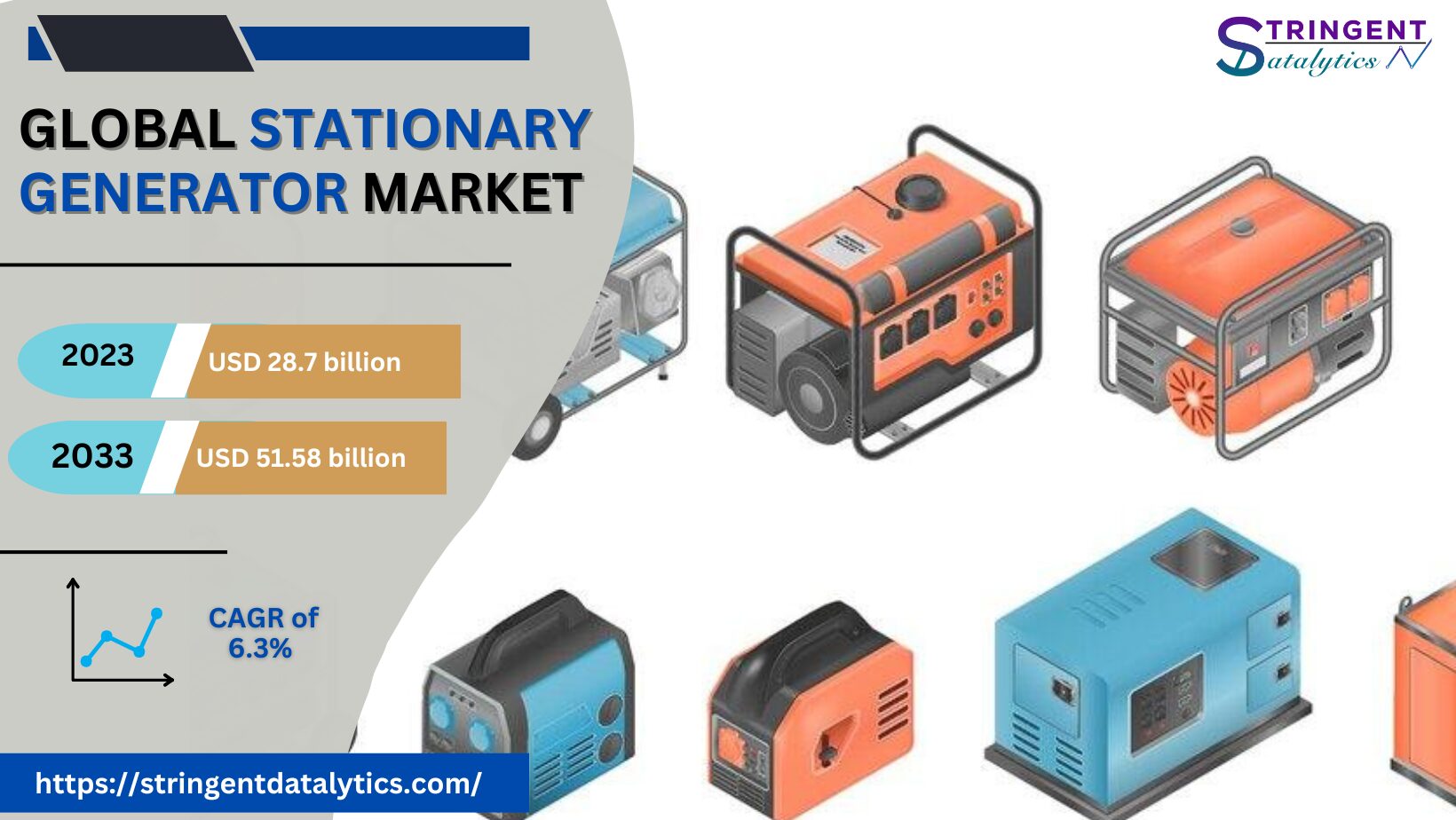The global stationary generator market is projected to reach USD 28.7 billion in 2023 to USD 51.58 billion in 2033, registering at a Compound Annual Growth Rate (CAGR) of 6.3% during the forecast period 2024-2033.
Introduction
The stationary generator market has evolved significantly over the years, driven by technological advancements, changing energy needs, and environmental concerns. This comprehensive overview delves into the working principles of stationary generators, traces historical developments in the market, explores current opportunities, and provides insights into why purchasing a report on this industry is essential. Additionally, frequently asked questions (FAQs) are addressed to provide a comprehensive understanding of the market landscape.
Working Principles of Stationary Generators
Stationary generators, also known as standby or backup generators, are critical components of power systems designed to provide electricity during grid outages or in off-grid applications. They operate on the principle of electromagnetic induction, converting mechanical energy into electrical energy through the interaction of magnetic fields.
The key components of a stationary generator include:
- Engine: Most stationary generators are powered by internal combustion engines fueled by diesel, natural gas, propane, or biogas. These engines drive the generator’s alternator to produce electricity.
- Alternator: The alternator consists of a rotor and a stator. When the engine drives the rotor, it induces an alternating current (AC) in the stator windings through electromagnetic induction.
- Voltage Regulator: The voltage regulator maintains a constant voltage output from the generator by adjusting the excitation current to the alternator’s rotor.
- Control Panel: The control panel monitors and controls the generator’s operation, including starting, stopping, and transferring load during power outages.
- Cooling System: Stationary generators require effective cooling systems to dissipate heat generated during operation, ensuring optimal performance and longevity.
During normal operation, stationary generators remain on standby mode, ready to supply power when the utility grid fails. When a power outage occurs, automatic transfer switches (ATS) detect the loss of utility power and command the generator to start automatically. Once the generator reaches the required voltage and frequency, it begins supplying electricity to the connected loads until utility power is restored.
Historical Developments and Opportunities
1. Early Developments: Stationary generators have been in existence for over a century, initially developed for industrial and military applications. Early generators were large and cumbersome, primarily fueled by diesel or gasoline, and required manual intervention to start and operate.
2. Technological Advancements: Over the years, advancements in engine technology, materials science, and control systems have revolutionized the stationary generator market. Modern generators are more compact, fuel-efficient, and environmentally friendly, with sophisticated control features for seamless integration into power systems.
3. Market Expansion: The stationary generator market has witnessed significant expansion driven by various factors, including:
- Increasing Power Demand: Rising global energy demand, especially in developing regions, has fueled the deployment of stationary generators to supplement inadequate grid infrastructure and ensure reliable power supply.
- Growing Need for Resilience: With the increasing frequency and severity of weather-related disasters and grid failures, there is a growing emphasis on resilience and backup power solutions, driving the demand for stationary generators in commercial, industrial, and residential sectors.
- Emergence of Renewable Integration: Stationary generators are increasingly integrated into hybrid power systems alongside renewable energy sources like solar and wind, providing reliable backup power and grid stabilization capabilities.
- Advancements in Microgrid Technology: The proliferation of microgrids, especially in remote and off-grid areas, presents opportunities for stationary generator manufacturers to provide customized power solutions tailored to specific needs and applications.
4. Shift towards Sustainable Solutions: Environmental concerns and regulatory initiatives aimed at reducing greenhouse gas emissions have prompted a shift towards cleaner fuel options such as natural gas, biogas, and hydrogen in stationary generators. This transition presents opportunities for market players to develop eco-friendly solutions and capitalize on the growing demand for sustainable energy technologies.
5. Innovation in Remote Monitoring and Control: Advancements in digitalization, IoT, and cloud computing have enabled remote monitoring, predictive maintenance, and real-time optimization of stationary generators. Manufacturers are leveraging these technologies to offer value-added services, enhance operational efficiency, and differentiate their products in the market.
Receive the FREE Sample Report of Stationary Generator Market Research Insights @ https://stringentdatalytics.com/sample-request/stationary-generator-market/14323/
Market Segmentations:
Global Stationary Generator Market: By Company
Briggs & Stratton
Caterpillar
Cummins
Generac
Kohler
Global Stationary Generator Market: By Type
Stationary Diesel Generators
Stationary Gas Generators
Global Stationary Generator Market: By Application
Industrial
Commercial
Residential
Regional Analysis of Global Stationary Generator Market
All the regional segmentation has been studied based on recent and future trends, and the market is forecasted throughout the prediction period. The countries covered in the regional analysis of the Global Stationary Generator market report are U.S., Canada, and Mexico in North America, Germany, France, U.K., Russia, Italy, Spain, Turkey, Netherlands, Switzerland, Belgium, and Rest of Europe in Europe, Singapore, Malaysia, Australia, Thailand, Indonesia, Philippines, China, Japan, India, South Korea, Rest of Asia-Pacific (APAC) in the Asia-Pacific (APAC), Saudi Arabia, U.A.E, South Africa, Egypt, Israel, Rest of Middle East and Africa (MEA) as a part of Middle East and Africa (MEA), and Argentina, Brazil, and Rest of South America as part of South America.
Click to Purchase Stationary Generator Market Research Report @ https://stringentdatalytics.com/purchase/stationary-generator-market/14323/?license=single
Why Purchase a Report on the Stationary Generator Market?
Purchasing a comprehensive report on the stationary generator market offers numerous benefits, including:
- In-depth Market Analysis: Reports provide detailed insights into market dynamics, trends, challenges, and opportunities, enabling stakeholders to make informed decisions and formulate effective strategies.
- Market Size and Forecast: Reports offer accurate assessments of market size, growth projections, and demand trends, helping investors and businesses identify lucrative opportunities and allocate resources efficiently.
- Competitive Landscape: Reports analyze the competitive landscape, including key players, market share, and strategic initiatives, facilitating benchmarking, competitor analysis, and market positioning.
- Regulatory and Policy Analysis: Reports provide updates on regulatory frameworks, policy developments, and industry standards impacting the stationary generator market, helping stakeholders navigate compliance requirements and regulatory risks.
- Investment and Expansion Opportunities: Reports highlight emerging markets, investment opportunities, and growth prospects, assisting companies in identifying new markets, diversifying portfolios, and expanding their presence globally.
- Risk Assessment and Mitigation Strategies: Reports assess market risks, challenges, and uncertainties, enabling stakeholders to develop risk mitigation strategies, adapt to market dynamics, and safeguard against potential disruptions.
- Customized Research Services: Many report providers offer customized research services, allowing clients to request tailor-made reports, market surveys, and consulting services to address specific research objectives and information needs.
Overall, purchasing a report on the stationary generator market is essential for stakeholders seeking to stay abreast of industry developments, capitalize on emerging opportunities, and navigate the complexities of the market landscape effectively.
FAQ
- What are the key applications of stationary generators? Stationary generators are used across various sectors, including commercial buildings, industrial facilities, data centers, healthcare facilities, telecommunications, and residential properties, to provide backup power during grid outages or as primary power sources in off-grid locations.
- What factors should be considered when selecting a stationary generator? Factors to consider include power requirements, fuel type, emissions regulations, installation space, maintenance requirements, reliability, and cost considerations.
- What are the different fuel options available for stationary generators? Stationary generators can be powered by diesel, natural gas, propane, biogas, or hydrogen, with each fuel option offering unique advantages and considerations in terms of cost, availability, emissions, and environmental impact.
- How do standby generators differ from prime generators? Standby generators are designed for backup power applications and typically operate for short durations during grid outages, whereas prime generators are intended for continuous or primary power generation in off-grid or remote locations where utility power is unavailable or unreliable.
- What are the maintenance requirements for stationary generators? Maintenance requirements vary depending on factors such as usage, operating conditions, fuel type, and manufacturer recommendations. Routine maintenance tasks may include oil and filter changes, fuel system checks, cooling system inspections, and periodic load testing to ensure optimal performance and reliability.
About Stringent Datalytics
Stringent Datalytics offers both custom and syndicated market research reports. Custom market research reports are tailored to a specific client’s needs and requirements. These reports provide unique insights into a particular industry or market segment and can help businesses make informed decisions about their strategies and operations.
Syndicated market research reports, on the other hand, are pre-existing reports that are available for purchase by multiple clients. These reports are often produced on a regular basis, such as annually or quarterly, and cover a broad range of industries and market segments. Syndicated reports provide clients with insights into industry trends, market sizes, and competitive landscapes. By offering both custom and syndicated reports, Stringent Datalytics can provide clients with a range of market research solutions that can be customized to their specific needs.
Reach US
Stringent Datalytics
+1 346 666 6655
Social Channels:




Leave a Reply